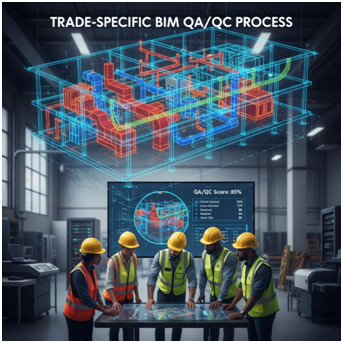In the high-stakes world of construction, project managers are constantly pressured to deliver faster, reduce rework, and keep budgets in check. One of the most powerful tools available for achieving these outcomes is a well-structured, trade-specific BIM QA/QC process. When executed effectively, such a process can reduce RFIs (Requests for Information) by up to 70%, saving valuable time and resources during project execution
Why Trade-Specific QA/QC Matters in BIM
Example: Low Voltage Modeling Success
Take, for instance, a recent 250,000+ sq ft net-zero mixed-use campus we supported. Through rigorous trade-specific BIM standards aligned with NEC and NFPA 72, we helped our client avoid costly field revisions and meet aggressive phased turnover deadlines, all while integrating complex low-voltage systems across lab, office, and residential zones.

The 6-Step Trade-Specific BIM QA/QC Framework
1. Define Discipline-Specific BIM Standards
Start by establishing clear modeling and documentation standards for each trade. These should reflect applicable codes (e.g., NEC, IPC, SMACNA), manufacturer specifications, and constructability requirements. Include:
- Modeling conventions (level of detail, family naming)
- Routing constraints (clearances, spacing)
- Required metadata (e.g., asset tags, voltage levels)
2. Leverage Coordinated Modeling Templates
Use pre-configured Revit templates customized per trade. This ensures uniformity across project files and streamlines onboarding of new modelers. These templates should contain:
- Preloaded families compliant with trade standards
- Annotation styles and shared parameters
- View templates for shop drawing generation
3. Conduct Internal Clash Checks Before Federation
Instead of relying solely on the general contractor’s Navisworks model for clash detection, perform trade-specific clash checks internally. This “pre-screening” step lets you resolve many issues before they’re exposed in coordination meetings.
Tools: Autodesk Revit + Navisworks Manage or BIM Track for trade-level clash workflows.
4. Use Structured Model QA Checklists
Each model submission should be reviewed against a trade-specific checklist covering:
- Completeness (all scope elements modeled)
- Accuracy (real-world constructability)
- Standards compliance (naming, parameters)
- Documentation readiness (sheets, tags, dimensions)
Checklists serve as both a training tool and a quality gate before external coordination.
5. Implement Phase-Based Review Gates
Embed QA/QC reviews into project milestones (e.g., SD → DD → CD → IFC). At each gate:
- Validate LOD progression
- Lock in coordination zones
- Confirm routing within allowable tolerances
- Freeze scope for prefabrication elements
This ensures that key details are caught at the right time, before they create downstream RFIs.
6. Integrate Shop Drawing Production Into QA Process
The final deliverable for trades should not just be a model, it should be a complete set of shop drawings validated for constructability. BIM QA should confirm:
- Correct device placements and quantities
- Coordination of hangers, sleeves, and offsets
- Compatibility with field installation methods
Deliverables: Floorplans, RCPs, 3D isometrics, installation sheets.
Results You Can Expect
By adopting this structured QA/QC workflow, construction teams have consistently achieved:
- 70% reduction in RFIs related to trade coordination
- Faster prefabrication timelines due to early lock-in of coordinated systems
- Greater trust with field teams, who receive constructible, accurate shop drawings
- Reduced rework and material waste, improving both margins and schedules
Lessons from the Field
Final Thoughts: Build QA/QC Into Your Culture
Project managers don’t need to wait for problems to occur to solve them. By embedding a trade-specific QA/QC process into your BIM execution from day one, you’re not just reducing RFIs, you’re protecting your schedule, your budget, and your reputation.
At Bay BIM Designs, we specialize in backend support that lets you operate seamlessly. Whether you’re managing a fast-paced healthcare facility or a high-density residential tower, our QA-first approach ensures that what gets modeled actually gets built, accurately and efficiently.
Want to see how our QA/QC workflows could reduce RFIs on your next project?
Contact us for a sample or schedule a discovery call.

